Analyzing Urban Public Policies of the City of Ensenada in Mexico Using an Attractive Land Footprint Agent-Based Model
Abstract
1. Introduction
2. Methodology
2.1. Data Requirements
- (1)
- Spatial data layers. For this current exercise, the layers were composed of the city´s polygon boundaries, sub-sectors boundaries, urban grid, water bodies, terrain slope, agricultural zones, developed land, non-developable land, developable land, road structure, and current land uses. They should be in SHP or ASC format, depending on the case (Table A2 in Appendix B).
- (2)
- Urban development plan regulations applicable to the human settlement to be modeled. The spatial data layers and the Urban Development Plan (Table A3 in Appendix B) must belong to the same time cut. For this exercise, the Land Use Compatibility Matrix was used as the regulatory norm to be evaluated.
2.2. Model Verification and Validation
2.2.1. Model Verification
- (1)
- Developable land. Land uses should only grow on developable land and in previously established slope ranges.
- (2)
- Compatibility matrix. According to the subsector where they are located, the land uses that grow on the territory are only those allowed by the compatibility matrix.
- (3)
- Adjacency matrix. Adjacent land uses must be those that are only permitted by an adjacency matrix.
- (4)
- Population projection. The current and projected population for each year should be the same. This comparison will be made with ex-ante scenarios, that is, with previously known results.
- (5)
- Urban surface. The amount of urban surface generated each year should correspond to population projection and density established at the beginning of the model’s execution.
2.2.2. Model Validation
2.2.3. Sample Space
2.3. Experiments
3. Simulation Results Analysis and Discussion
3.1. Total Attractive Land Footprint
3.2. Percentage of Urbanized Attractive Land Footprints
3.3. Urbanized Attractive Land Footprint Differentiated by Compatibility
3.4. Urbanized Attractive Land Footprint Differentiated by Land Use
3.5. Industry Location Differentiated by Compatibility with the UDPE
3.6. Attractive Land Footprint States
4. Conclusions
Supplementary Materials
Author Contributions
Funding
Institutional Review Board Statement
Informed Consent Statement
Data Availability Statement
Acknowledgments
Conflicts of Interest
Abbreviations
| IMIP | Instituto Metropolitano de Investigación y Planeación del Municipio Ensenada |
| UDPE | Urban Development Plan of Ensenada |
| ALF | Attractive Land Footprints |
| ODD | Overview, Design Concepts, and Details protocol |
| ABM | Agent-Based Models |
| MAS | Multi-Agent Systems |
Appendix A. Complementary Tables and Figures
Appendix A.1. Attractive Factors by Land-Use Type
| Factor | Housing | Commercial | Industry | Tourism | Equipment |
|---|---|---|---|---|---|
| Job offer | • | ||||
| Labour | • | • | • | ||
| Services | • | • | • | • | |
| Cost of affordable land | • | • | • | • | • |
| Physical risk | |||||
| Beach | • | • | |||
| Roads | • | • | • | • | • |
| Transfer time | • | • | • | ||
| Downtown centers | • | • | |||
| Transport systems | • | • | • | • | |
| Existing development | • | • | • | • | |
| Housing | • | • | • | ||
| Infrastructure | • | • | • | • | • |
| Building land | • | • | • | • | • |
| Income level | • | ||||
| Elevation | • | ||||
| Flood zones | |||||
| Water bodies (Streams, lakes) | • | • | |||
| Industrial density | • | • | |||
| light industry | • | ||||
| Urban sub-centers | • | • | • | ||
| Railway | • | • | |||
| Total saleable area | • | • | • | ||
| Green areas | • | • | |||
| Weather | • | • | |||
| Scenic views | • | • | |||
| Agricultural areas | |||||
| Dumpsters | |||||
| Urban periphery | • | ||||
| Schools | • | • | • | ||
| Hospitals | • | • | • | ||
| Sports equipment | • | • | • | ||
| Soft slope | • | • | |||
| Zoning | • | • | • | • | • |
| Rural areas | • | • | |||
| Price of water | • | • | |||
| Housing density | • | • | • | ||
| Commercial density | • | • | • | ||
| Industrial density | • | • | |||
| Airports | • | • | |||
| Natural protected areas | • | ||||
| Protected historical sites | • | ||||
| Rights of way | |||||
| Military facilities | |||||
| Pantheons | |||||
| Loading terminals | • | • |
Appendix B. Modeling and Simulation Process
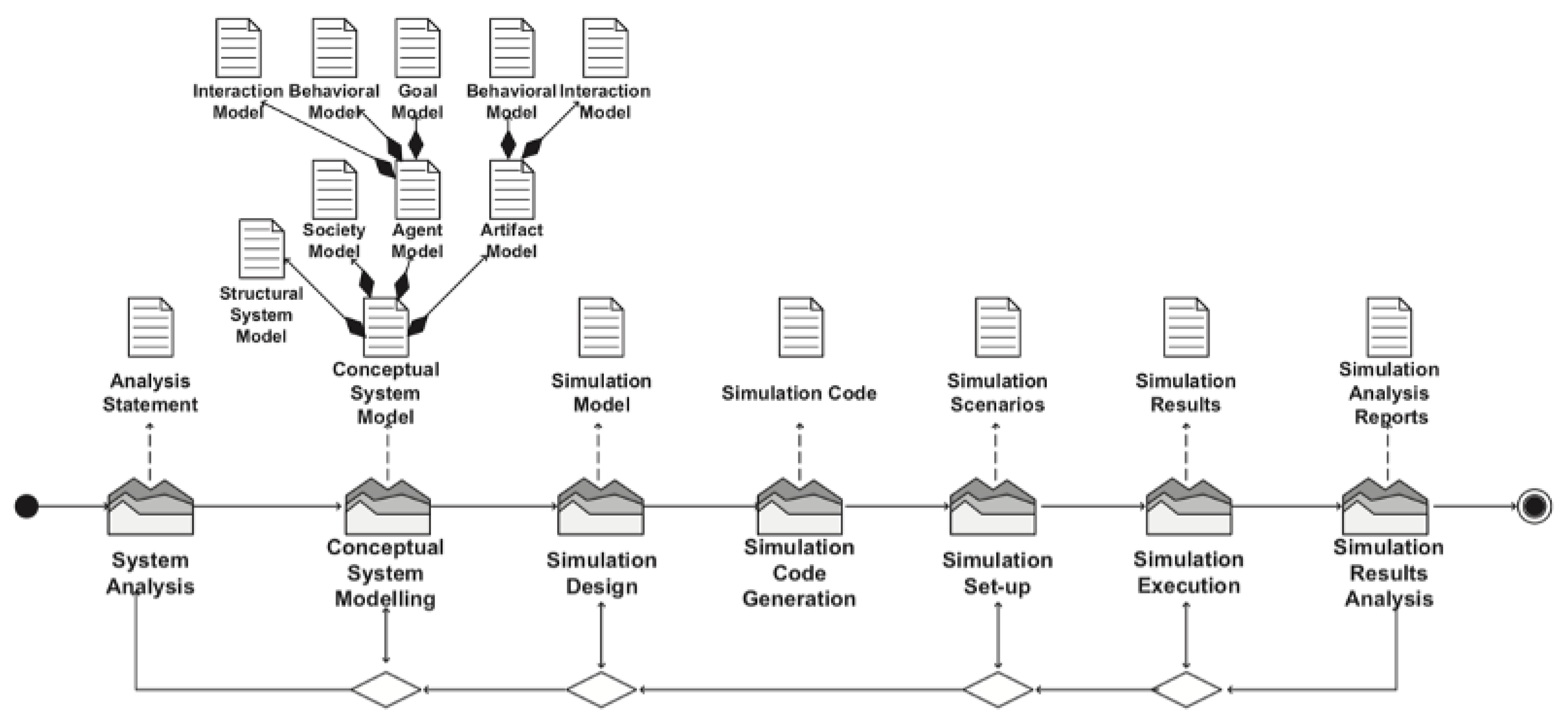
Appendix B.1. Data Requirements
- (1)
- Spatial data layers. They should be in SHP or ASC format, depending on the case (Table A2).
- (2)
- Urban development plan applicable to the human settlement to be modeled. The spatial data layers and the Urban Development Plan (Table A3) must belong to the same time cut. Usually, the layers are derived from the work done to make the Plan.
| Data | Format | Type |
|---|---|---|
| City limits polygon | SHP | Vector |
| Citiy sub-sectors | SHP | Vector |
| Urban grid | SHP | Polygon |
| Water bodies | SHP | Polygon |
| Slope | SHP | Raster |
| Agricultural zones | SHP | Polygon |
| Developed land | SHP | Polygon |
| Developable land | SHP | Polygon |
| Non-developable land | SHP | Polygon |
| Road structure | SHP | Vector |
| Land use | SHP | Polygon |
| Information | Type |
|---|---|
| Land Use Compatibility Matrix | Table |
| City limits polygon | Map |
| Sectors/subsectors | Map |
| Population historic growth | Table/Plot |
| Population growth projection | Table/Plot |
| Current urban surface | Table |
| Current land use surfaces | Table/Plot |
| Population growth rate | Table/Plot |
| % of industry compatible with Urban Development Plan regulation | Table/Plot |
| Population density (inhabitants per hectare) | Table |
Appendix B.2. Data Preparation
Appendix B.3. Land Use Compatibility Matrix
- (1)
- Conditioned land uses. According to this model’s scope, to correctly read the Land-Use Compatibility Matrix, it must only contain compatibilities and incompatibilities concerning urban sub-sectors. The model does not accept conditioned uses, which are common in these matrices in Urban Development Plans. For this reason, it is necessary to evaluate which conditioned land uses will be converted into compatible or incompatible uses.
- (2)
- Land uses that do not represent surfaces. Uses that do not manifest themselves as a surface in real life will be eliminated to avoid an erroneous spatial representation in the model results. Examples are bicycle paths added to existing roads which do not represent an additional urban area, ATMs that are an integral part of other land uses, or campsites that are temporary, seasonal, minimal, and removable.
- (3)
- Unique or existing land uses. Care should be taken that the model does not result in land uses that are unique or have already been constructed after elaborating the Urban Development Plan. This information is entered, so no more instances are replicated once a land-use of this nature is built in a simulation. Examples of this type of land use are City Hall that only exists one per population center, Dam, Railroad, Market, and Regional Hospital. Population center size must be considered to determine whether a land use will be unique, under the logic that as the population is larger, the less likely it is to be unique.
- (4)
- Urban corridors, urban centers and sub-centers. The model can read geographic spaces delimited by closed polygons and vectors, and therefore can read spatial information expressed in that way. Any other spatial expression expressed only in an indicative way and not represented by polygons or vectors will be eliminated from the compatibility matrix. Examples of these elements are the urban corridors that are usually marked as a point on the maps.
Appendix B.4. Spatial Data Layers
- (1)
- City’s polygon. Correspond with the polygon indicated in the Urban Development Plan.
- (2)
- City’s sub-sectors. Correspond with the sub-sectors of the Land Use Compatibility Matrix of the Urban Development Plan. The attributes table corresponding to this information layer must contain the following columns:
- (a)
- SUB-SECTOR (which contains the sub-sector’s name of the corresponding polygon).
- (b)
- COUNT (which contains the value 1 for all the sub-sectors, to differentiate in the model the territory inside the city’s polygon from the one outside)
- (3)
- Urban grid. It contains all the blocks and other urbanized areas included within the city’s polygon. The attributes table corresponding to this information layer must have the following column:
- (a)
- URBAN (which contains the value 1 for each of the blocks and other urbanized areas of the city).
- (4)
- Water bodies. Correspond to lakes, dams, rivers, streams, and coasts within or adjacent to the city’s limits.
- (5)
- Slope. It is classified by range. If the Urban Development Plan has a threshold of urbanization concerning slopes, it must be manifested as a range limit.
- (6)
- Agricultural zones. They are the parcels that compose farms and cultivation areas. If there are other uses within them, they must be included. The attributes table corresponding to this layer of information must contain the following column:
- (a)
- ZONING (which will contain the value 1 for each plot).
- (7)
- Developed land, non-developable land and developable Land. These three layers derive from the territorial aptitude model for the Urban Development Plan. If the model is unavailable, developed land data is obtained from the existing urban grid. Developable land is where no urbanization should be allowed for reasons of risk, conservation, or growth policies such as steep slopes, rivers, streams, coastal dunes, wetlands, geological faults, and outstanding natural areas. Developable land is the territory that remains on which it is possible to build according to urban policies that allow it.
- (8)
- Road structure. It is composed of roads and highways, differentiated in the corresponding layer’s attributes table. In-project roads are also included. The inclusion of secondary roads must be assessed if they could be used by heavy traffic. Local or service roads are excluded.
- (9)
- Land uses. It must contain the current land uses of the urban area. There must be a correspondence between these land uses and the Land Use Compatibility Matrix. The attribute table for this data layer must contain the following column:
- (a)
- LAND_USE (which contains the name of the land use type of each polygon to which the value is assigned).
Appendix C. The Model
Appendix C.1. Overview, Design Concepts, and Details (ODD Protocol)
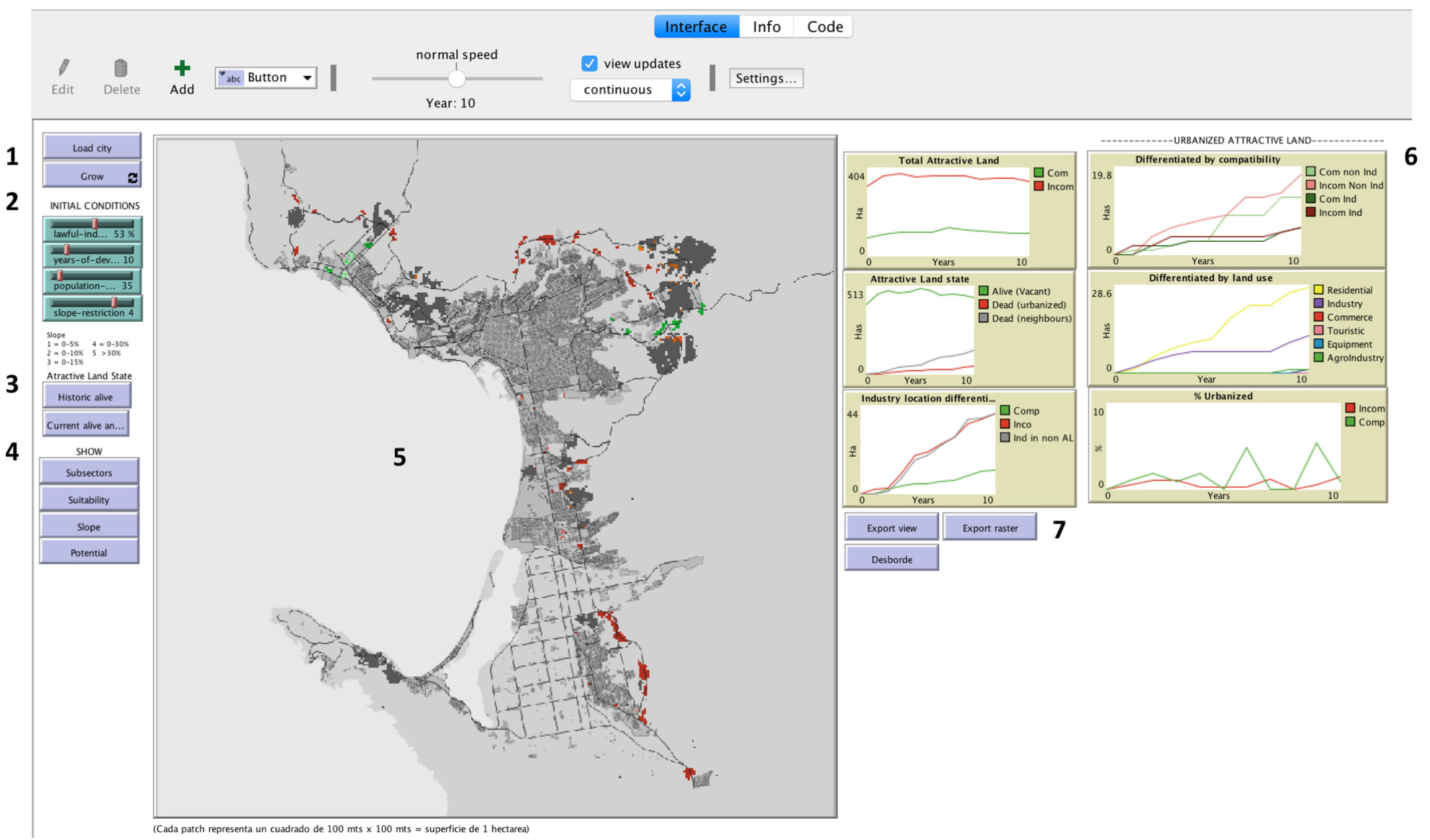
Overview
Purpose
Entities, State Variable and Scales
- (1)
- Low-level variables. These are variables that cannot be deduced from other low-level variables because they are elementary properties of the entity. Each cell of land contains the following low-level variables (Table A4).
- (2)
- Attractive land. Attractive Land is not a land use but vacant land suitable for industry from a developer’s perspective. As such, in contrast to land uses that once they urbanize a cell is stays the same for the rest of the simulation, Attractive Land rises and diminishes on places that are urbanized or that aggregate favorable conditions for industry.
- (3)
- Land use. It represents the activity that that takes place in the cell. It can be of 7 general types, or it can also be vacant, which means that there is no current activity. The 7 general types are subdivided into 111 specific land uses according to the UDPE. The 7 general types are Residential, Touristic, Industrial, Agro-Industrial, Commercial, Equipment, and Farmland. For visualization purposes, Industry land use appears as orange cells, and the rest of land uses are gray.
- (4)
- Interest. It represents the interest of a cell to develop a land use. This interest can be one of the land uses specified in a UDPE´s Land Use Compatibility Matrix.
- (5)
- Urban. Indicates if the cell is occupied by a land use.
- (6)
- Row, column. Values that correspond to the location in the Land Use Compatibility Matrix and the Subsector being analyzed. These values are necessary so that the model can properly read this Matrix.
- (7)
- Attraction. A value that specifies the level of attraction of a cell for industrial activities. The greater the value, the greater the attraction. The highest values are those that are considered as Attractive Land. Attractive Land is not a constructed land use but rather a vacant land that contains a specific set of characteristics that make it attractive for industrial use from a developer’s point of view. As such, and in contrast to urbanized land that remains in that state for the rest of the simulation, Attractive Land constantly changes its spatial pattern, or footprint, over time: it shrinks and disappears in areas that are gradually urbanized or emerges, grows and even moves where favorable conditions for the industry are agglomerated.
- (8)
- Intersected by a street? It species whether the cell is intersected by a street/road or not. The Street/road network is obtained from the UDPE and includes current and projected network.
- (9)
- Suitable? Conditions that must be met for a cell to be urbanized for any land use or can be considered Attractive Land. These conditions are: that the cell is inside city limits, that it is developable, that it is vacant, that it is not farmland, and that it is not a water body.
- (10)
- City sub-sector. The city polygon is divided into 5 main sectors and subdivided in 61 sub-sectors according to the Urban Development Plan (Figure 2). The city limits polygon is greater than the current urban surface, so it also contains natural areas. Each one of the 111 specific land uses are compatible, or not, with each one of the 61 sub-sectors. Sub-sectors and compatibilities are taken from the Compatibility Matrix of the UDPE.
- (11)
- Developable? The city’s polygon is composed of areas that are developable or non-developable. Non-developable areas represent streams, farmland, geologic faults, natural land, steep slopes and land 200 meters above sea level. The rest of the surface is developable land, including vacant lots inside the city. These areas are obtained from the UDPE.
- (12)
- Potential random value that changes over time. It refers to the potential of vacant land to be developed. If this value is greater that an established threshold, the vacant land holding this value is urbanized and stays urbanized. Value is estimated according to the Vicsek-Szalay model that is later explained.
- (13)
- Slope. It is the angle of terrain expressed in ranges: 1 = 0–5%, 2 = 0–10%, 3 = 0–15%, 4 = 0–30%, 5 > 30%.
- (14)
- Body of water? It specifies if the cell is water.
- (1)
- Potential threshold. All cells have a variable called Potential, which is continuously updated. An interest in developing a land use is assigned to cells that exceed this value previously established by the user.
- (2)
- Adjacency matrix. Matrix that specifies desired/undesired adjacency between land uses. It is designed from empirical evidence of land uses from the city of Ensenada.
- (3)
- Lawful industry percentage. From the total of times the model tries to grow industry in incompatible zones, this is the percentage of times the model will allow it. This does not necessary mean that industry will be built, because the terrain must satisfy a series of additional requirements for this land use.
- (4)
- Growth rate. Value that determines the average increase in the population. It is based on recent census data.
- (5)
- Years of development. The years the model will simulate.
- (6)
- Number of inhabitants. The model starts with a fixed population number according to recent census data, and is projected in a time span equal to Years of development variable. The amount of land uses that the model outputs depends on population size which in turn depends on the Population density variable.
- (7)
- Land use compatibility matrix. Matrix that specifies compatibility between each one of the 111 specific land uses and 61 subsectors, resulting in 6771 combinations. The concept of compatibility is not related to the adjacency of land uses, but to the permission of a land use to take place inside a city subsector, and is obtained from the Land Use Compatibility Matrix of the UDPE. In this sense, the compatibility of each cell with each one of the 111 land uses will depend on the subsector is in.
- (8)
- Population density. Inhabitants per hectare.
- (9)
- Slope restriction. Angle of terrain. Permitted slopes upon which urbanization can occur. Slopes are obtained from the UDPE.
- (10)
- Public policies. Actions to regulate urban growth. They are:
- (a)
- Population density: Inhabitants per hectare.
- (b)
- Slope restriction: Angle of terrain. Permitted slopes upon which urbanization can occur. Slopes are obtained from the UDPE.
| Type | Entity | Variables | Expression | Changes Over Time? |
|---|---|---|---|---|
| Attractive land | Alive | Yes | ||
| Dead | ||||
| Vacant | Yes | |||
| Residential | ||||
| Touristic | ||||
| Industrial | ||||
| Land use | Agro-Industrial | No | ||
| Commercial | ||||
| Equipment | ||||
| Farmland | ||||
| Residential | ||||
| Touristic | ||||
| Industrial | ||||
| Interest | Agro-Industrial | Yes | ||
| Commercial | ||||
| Equipment | ||||
| Farmland | ||||
| Grid cell | Land | Urban | Si | Yes |
| No | ||||
| Row | Value established by the Compatibility Matrix | Yes | ||
| Column | Value established by the Compatibility Matrix | Yes | ||
| Attraction | Numeric value stated by model | Yes | ||
| Intersected by a street? | Yes | No | ||
| No | ||||
| Suitable? | Yes | Yes | ||
| No | ||||
| City sub-sector | Polygons established by the PDU | No | ||
| Developable? | Yes | Yes | ||
| No | No | |||
| Potential | Numerical value stated by sub-model | Yes | ||
| 0-5% | ||||
| 0–10% | ||||
| Slope | 0–15% | No | ||
| 0–30% | ||||
| >30% | ||||
| Body of water? | Yes | No | ||
| No | ||||
| Urbanization threshold | Potential threshold | Numerical value stated by sub-model | Yes | |
| Land use neighbor preference | Adjacency Matrix | Desirable | No | |
| Not desirable | ||||
| Urban development program compliance | % Lawful industry | Numerical value stated by model user | No | |
| Growth rate | Numerical value stated by model user | No | ||
| Environment | Population | Years of growth | Numerical value stated by model user | No |
| Number of inhabitants | Numerical value stated by model user | Yes | ||
| Land use Compatibility Matrix | Compatible | No | ||
| Incompatible | ||||
| Population density | Numerical value stated by model user | No | ||
| Public policies | 0–5% | No | ||
| 0–10% | ||||
| Slope restriction | 0–15% | |||
| 0–30% | ||||
| >30% |
Process Overview and Scheduling
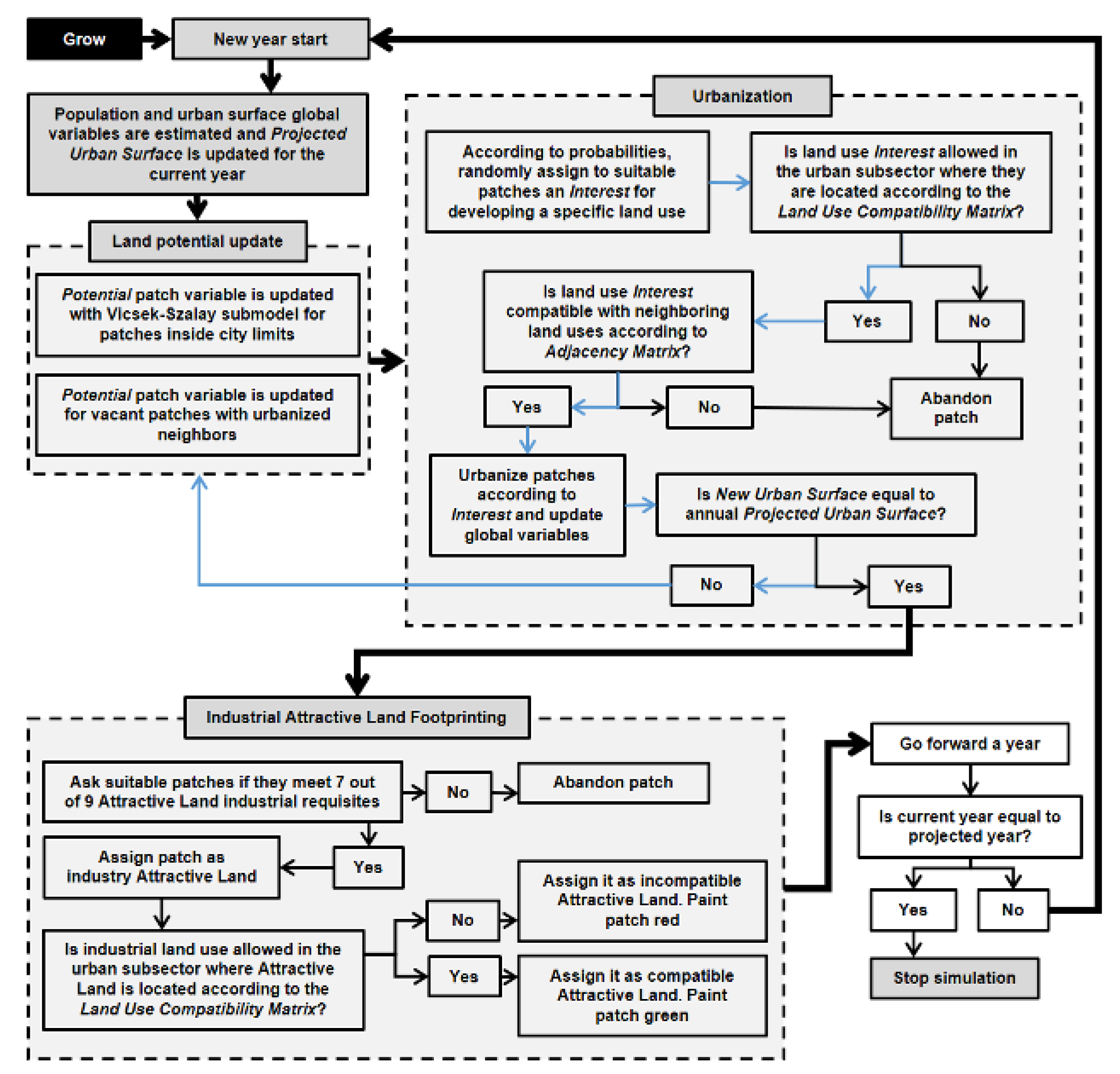
- (1)
- Setup. This is the first step of the model where pre-established numerical and spatial layers of data are loaded that together form the initial urban state of the model.
- (2)
- Assign initial attractive land. Based on the initial spatial conditions of the model, it identifies the initial Attractive Land.
- (3)
- Assign random value to cells. The model randomly assigns a value of 1 or -1 to a cell variable called Potential to all cells that are inside of the city polygon. This will be the base for the Vicsek-Szalay sub-model which determines if a vacant cell has potential for urbanization. Each land use has location requirements, mainly its compatibility to sub-sectors of the city and its preference to neighbor land uses (See Table A5).
- (4)
- Estimate amount of projected urban surface. Based on initial population, growth rate, and population density, and amount of urban surface is projected for one year. The simulation stops once the current year equals the Years of development variable.
- (5)
- Compare current vs projected urban surface. Projected urban surface is compared to growing urban surface. While the growing urban surface does not match projected urban surface, model will loop the following steps. If this condition is met, it exits the loop, advances by one year, plots and spatial pattern of land-uses is updated, and starts a new loop by estimating new projected urban surface.
- (6)
- Update potential variable for each cell. All cells update their Potential variable according to the Vicsek-Szalay model. Additionally, urbanized cells rise the Potential variable of neighboring vacant cells. If the final value of this variable is higher than an stabilised threshold, only cells meeting this requirement proceed to the next step.
- (7)
- Assign random land-use interest to cells with potential above threshold value. One of 111 possible land-uses is randomly assigned as a land use interest to the cells above threshold. It is assigned according to pre-established probabilities and represents an interest of the cell to develop that land-use. The probabilities are based on the proportion of land uses stated as current by the UDP.
- (8)
- Validate the assigned land use with the compatibility matrix. The model verifies with the Land Use Compatibility Matrix if the randomly assigned land use interest is compatible with the sub-sector it’s in. If its compatible, proceeds to next step.
- (9)
- Verify neighbors. The model verifies with the Adjacency Matrix that neighboring requirements by the land use interest can be met.
- (10)
- Urbanize cell with land-use interest. If compatibility and requirements are fully satisfied, the cell is urbanized with the land-use interest, and Land Use, Developable?, Suitability, Farmland and Urban cell variables are updated. The last three are high-level variables that are deduced from low-level variables previously explained. Suitability establishes if a cell can be urbanized taking into account public policies, developable and vacant land and if its inside the city polygon. Farmland states if the cell is used for agricultural activities and Urban if the cell is occupied by a land-use. A global variable called New Urban Surface is also updated each time a cell is urbanized.
- (11)
- Compare current urban surface with projected urban surface. If current urban surface has not reached the projected urban surface, the loop remains by starting a new Update potential variable for each cell step. If it does, exits the current year loop and proceeds to the next step.
- (12)
- Update attractive land. Based on the current spatial configuration of land uses, the model updates location and amount of Attractive Land.
- (13)
- Compare current year with years of development variable. If current year is the same as Years of development variable, the model stops and the spatial pattern of land-uses is updated, along with plots and monitors.
| Residential | Touristic | Industrial | Agro-Industrial | Commercial | Equipment | Beach | ||||
|---|---|---|---|---|---|---|---|---|---|---|
| Commercial Industry Compatible | Commercial Industry Incompatible | Commercial Industry Compatible | Commercial Industry Incompatible | |||||||
| Residential | O | O | X | X | O | O | O | O | O | |
| Touristic | O | O | X | X | O | O | O | O | (2) | |
| Industrial | X | X | O | O | O | X | O | X | O | |
| Agro-industrial | X | X | O | O | O | O | O | O | O | |
| Commercial | Commercial Industry compatible | (1) | O | O | O | O | O | O | O | O |
| Commercial Industry incompatible | (1) | O | X | X | X | O | X | O | O | |
| Equipment | Commercial Industry compatible | (1) | O | O | O | O | O | O | O | O |
| Commercial Industry incompatible | (1) | O | X | X | O | O | O | O | O | |
Appendix C.2. Design Concepts
Appendix C.2.1. Basic Principles
Emergence
Interaction
Stochasticity
Collectives
Observation
- (1)
- Total Attractive Land.
- (2)
- Attractive Land State.
- (3)
- Industry location differentiated by compatibility.
- (4)
- Urbanized Attractive Land differentiated by: Compatibility, land use and percentage urbanized.
Appendix C.2.2. Details
Attractive Land
- (1)
- Land slope equal or lower than 15%.
- (2)
- 0 neighbors of residential land use.
- (3)
- 0 neighbors of touristic land use.
- (4)
- 0 neighbors of commercial land use that does not want to be adjacent to industry.
- (5)
- 0 neighbors of equipment land use that does not want to be adjacent to industry.
- (6)
- A regional road within a 2-cell radius.
- (7)
- 20 or more cells of residential land use within a 20-cell radius.
- (8)
- 4 or more cells of industrial land use within a 2-cell radius.
- (9)
- 2 or more cells of industrial land use in a 1 cell radius.
- (1)
- 1 or more neighbors of residential land use.
- (2)
- 1 or more neighbors of touristic land use.
- (3)
- 1 or more neighbors of commercial land use that does not want to be adjacent to industry.
- (4)
- 1 or more neighbors of equipment land use that does not want to be adjacent to industry.
Initialization
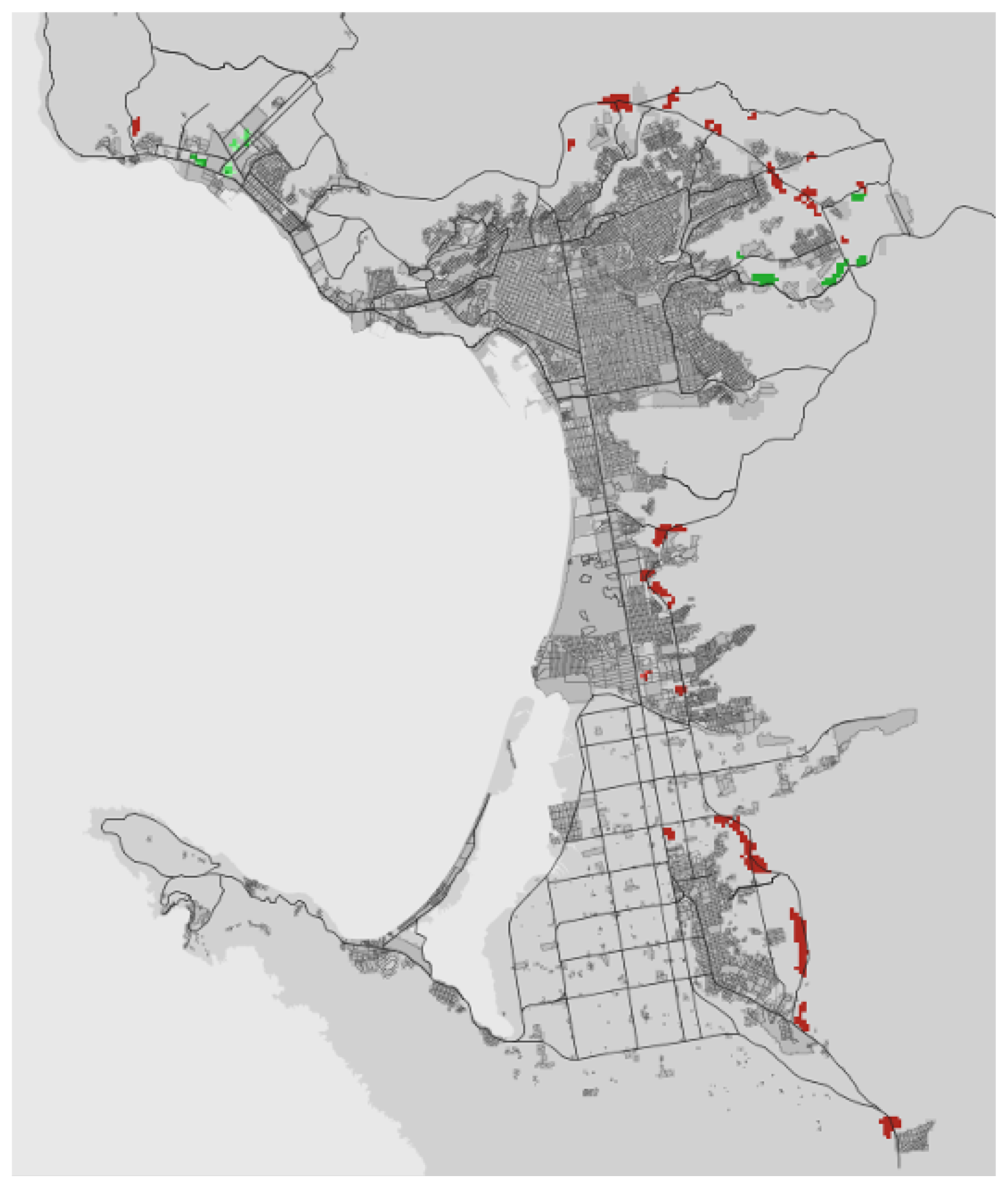
Input Data
- (1)
- Initial population: 363,260. Taken from the most recent census data.
- (2)
- Growth rate: 1.7. Obtained from the UDPE.
- (3)
- Lawful industry percentage: 53%. It was obtained from the Sectorial Industrial Development Program of Ensenada, which states that 47% of industry is located against urban regulations of the UDPE.
- (4)
- Years of development: 10. It is a time span in which it was considered by policy makers as adequate in a planning-revision context.
- (5)
- Population density: 35. It’s the current Ensenada’s average density according to the UDPE.
- (6)
- Slope restriction: 4. It corresponds to a slope range from 0 to 30%, which is close to current permitted urbanization on slopes not greater than 35% stated in the UDPE. The exact 35% value was not used due to technical challenges with available terrain data.
- (7)
- Threshold: 4. The value for the Vicsek-Szalay sub-model was chosen after empirical observation of values that better approximated Ensenada’s morphology.
Sub-Models
References
- IMIP. Programa Sectorial de Desarrollo Industrial de Ensenada; Instituto Metropolitano de Investigación y Planeación del Municipio Ensenada; Enseanda: Baja California, México, 2017. [Google Scholar]
- IMIP. Programa de desarrollo urbano de centro de población de Ensenada 2030. Periódico Oficial del Estado Baja California 2009, CXVI, 7–133. [Google Scholar]
- Economía, S.D. Norma Mexicana NMX-R-046-SCFI-2015 Parques Industriales—Especificaciones Industrial Parks-Specifications. Diario Oficial de la Federación 2017, 07/03/2017, 1–44. [Google Scholar]
- Bueno-Suárez, C.; Coq-Huelva, D. Sustaining what is unsustainable: A review of urban sprawl and urban socio-environmental policies in North America and Western Europe. Sustainability 2020, 12, 4445. [Google Scholar] [CrossRef]
- Bosch, M.; Chenal, J.; Joost, S. Addressing Urban Sprawl from the Complexity Sciences. Urban Sci. 2019, 3, 60. [Google Scholar] [CrossRef]
- Mitchell, M. Complexity: A Guided Tour, 1st ed.; Oxford University Press: New York, NY, USA, 2009; p. 349. [Google Scholar] [CrossRef]
- Filatova, T. Empirical agent-based land market: Integrating adaptive economic behavior in urban land-use models. Comput. Environ. Urban Syst. 2015, 54, 397–413. [Google Scholar] [CrossRef]
- Edmonds, B.; Meyer, R. Simulating Social Complexity: A Handbook, 1st ed.; Springer: Manchester, UK, 2013; p. 745. [Google Scholar]
- Weiler, R.; Engelbrecht, J. The new sciences of networks & complexity: A short introduction. Cadmus J. 2013, 2, 131–141. [Google Scholar]
- Beheshti, R.; Sukthankar, G. A Hybrid Modeling Approach for Parking and Traffic Prediction in Urban Simulations; Springer: Berlin/Heidelberg, Germany, 2014. [Google Scholar] [CrossRef]
- Easley, D.; Kleinberg, J. Networks, crowds, and markets: Reasoning about a highly connected world. Science 2010, 81, 744. [Google Scholar] [CrossRef]
- Morcol, G. Urban sprawl and public policy: A complexity theory perspective. Emerg. Complex. Organ. 2012, 14, 1–16. [Google Scholar]
- Batty, M. Cities as Complex Systems: Scaling, Interaction, Networks, Dynamics and Urban Morphologies. In Encyclopedia of Complexity and Systems Science; Springer: London, UK, 2009; pp. 1041–1071. [Google Scholar] [CrossRef]
- Portugali, J.; Meyer, H.; Stolk, E.; Tan, E. (Eds.) Complexity Theories of Cities Have Come of Age, 1st ed.; Springer: Berlin/Heidelberg, Germany, 2012; p. 438. [Google Scholar] [CrossRef]
- Atun, F. Understanding effects of complexity in cities during disasters. In Understanding Complex Urban Systems: Multidisciplinary Approaches to Modeling; Walloth, C., Gurr, J.M., Schmidt, J.A., Eds.; Springer: Berlin/Heidelberg, Germany, 2014; Volume 106, pp. 51–65. [Google Scholar] [CrossRef]
- Furtado, B.A.; Sakowski, P.A.M.; Tovolli, M.H. Modeling Complex Systems for Public Policy, 1st ed.; Institute for Applied Economic Research: Brasília, Brazil, 2015; Volume 37, p. 396. [Google Scholar]
- Gilbert, N.; Troitzcsch, K.G. Simulation for the Social Scientist, 2nd ed.; Open University Press: Glasgow, Scotland, 2005; p. 295. [Google Scholar]
- OECD; Global Science Forum. Applications of Complexity Science for Public Policy: New Tools for Finding Unanticipated Consequences and Unrealized Opportunities; Technical Report September; The Organisation for Economic Co-operation and Development: Erice, Sicily, 2009. [Google Scholar]
- Goldstein, J. Emergence as a Construct: History and Issues. Emergence 1999, 1, 49–72. [Google Scholar] [CrossRef]
- Portugali, J. Complexity, Cognition and the City, 1st ed.; Springer: Berlin/Heidelberg, Germany, 2011; p. 421. [Google Scholar]
- Bazzanella, L.; Canerapo, L.; Corsiso, F.; Roccasalva, G. The future of cities and regions: Simulation, scenario and visioning, governance and scale. In Springer Geography; Bazzanella, L., Caneparo, L., Corsico, F., Roccasalva, G., Eds.; Springer: Berlin/Heidelberg, Germany, 2012. [Google Scholar]
- Huang, J.; Zhang, J.; Lu, X.X. Applying SLEUTH for Simulating and Assessing Urban Growth Scenario Based on Time Series TM Images: Referencing To a Case Study of Chongqing, China. Int. Arch. Photogramm. Remote. Sens. Spat. Inf. Sci. 2008, 37, 597–606. [Google Scholar]
- Hossain, S.; Scholz, W.; Baumgart, S. Translation of urban planning models: Planning principles, procedural elements and institutional settings. Habitat Int. 2015, 48, 140–148. [Google Scholar] [CrossRef]
- Amato, F.; Pontrandolfi, P.; Murgante, B. Supporting planning activities with the assessment and the prediction of urban sprawl using spatio-temporal analysis. Ecol. Inf. 2015, 30, 365–378. [Google Scholar] [CrossRef]
- Norte, N.; Pais, A. Cellular automata and urban studies: A literature survey. ACE Archit. City Environ. 2007, 1, 368–399. [Google Scholar] [CrossRef]
- Bretagnolle, A.; Daudé, E.; Pumain, D. From Theory to Modelling: Urban Systems as Complex Systems. Cybergeo Rev. Eur. GéOgraphie / Eur. J. Geogr. 2006, 1–17. [Google Scholar] [CrossRef]
- Inostroza, L.; Baur, R.; Elmar, C. Urban Sprawl and Fragmentation in Latin America: A Comparison with European Cities. The Myth of the Diffuse Latin American City; Working Paper LRB082510; Lincoln Institute of Land Policy: Cambridge, MA, USA, 2010. [Google Scholar]
- Crooks, A.; Patel, A.; Wise, S. Multi-agent systems for urban planning. In Technologies for Urban and Spatial Planning: Virtual Cities and Territories; IGI Global: Pennsylvania, PA, USA, 2014; pp. 29–56. [Google Scholar] [CrossRef]
- Watkiss, B.M. The SLEUTH Urban Growth Model as Forecasting and Decision-Making Tool. Ph.D. Thesis, Stellenbosch University, Stellenbosch, South Africa, 2008. [Google Scholar]
- Barredo, J.I.; Kasanko, M.; McCormick, N.; Lavalle, C. Modelling dynamic spatial processes: Simulation of urban future scenarios through cellular automata. Landsc. Urban Plan. 2003, 64, 145–160. [Google Scholar] [CrossRef]
- Healey, P. Urban Complexity and Spatial Strategies: Towards a Relational Planning for Our Times; Routledge: Abingdon, UK, 2008; p. 319. [Google Scholar] [CrossRef]
- Abdullah, J. City Competitiveness and Urban Sprawl: Their Implications to Socio-Economic and Cultural Life in Malaysian Cities; Elsevier: Amsterdam, The Netherlands, 2012. [Google Scholar] [CrossRef]
- Oryani, K.; Harris, B. Review of Land Use Models: Theory and Application. In Proceedings of the Sixth TRB Conference on the Application of Transportation Planning Methods, Oakland, AC, USA, 6 May 1997; pp. 80–91. [Google Scholar]
- Walloth, C.; Gurr, J.M.; Schmidt, J.A. (Eds.) Understanding Complex Urban Systems: Multidisciplinary Approaches to Modeling, 1st ed.; Springer: Cham, Switzerland, 2014; p. 158. [Google Scholar]
- Lechner, T.; Ren, P.; Watson, B.; Brozefski, C.; Wilensky, U. Procedural Modeling of Urban Land Use. In ACM SIGGRAPH 2006 Research Posters; Association for Computing Machinery: New York, NY, USA, 2006; p. 135-es. [Google Scholar] [CrossRef]
- Santé, I.; García, A.M.; Miranda, D.; Crecente, R. Cellular automata models for the simulation of real-world urban processes: A review and analysis. Landsc. Urban Plan. 2010, 96, 108–122. [Google Scholar] [CrossRef]
- Xia, L.; Gar-On, Y. Integration of Principal Components Analysis And Cellular Automata for Spatial Decision-Making and Urban Simulation. Sci. China Ser. D Earth Sci. 2002, 45, 521–529. [Google Scholar] [CrossRef]
- Fotheringham, A.S.; Rogerson, P.A. (Eds.) The SAGE Handbook of Spatial Analysis; Sage: Newcastle upon Tyne, UK, 2009; p. 526. [Google Scholar]
- Hosseinali, F.; Alesheikh, A.A.; Nourian, F. Agent-based modeling of urban land-use development, case study: Simulating future scenarios of Qazvin city. Cities 2013, 31, 105–113. [Google Scholar] [CrossRef]
- Hjorth, A.; Wilensky, U. Redesigning Your City—A Constructionist Environment for Urban Planning Education. Proc. Constr. 2014, 13, 1–10. [Google Scholar] [CrossRef]
- Ligmann-Zielinska, A.; Jankowski, P. Exploring normative scenarios of land use development decisions with an agent-based simulation laboratory. Comput. Environ. Urban Syst. 2010, 34, 409–423. [Google Scholar] [CrossRef]
- Vliet, J.V.; White, R.; Dragicevic, S. Modeling urban growth using a variable grid cellular automaton. Comput. Environ. Urban Syst. 2009, 33, 35–43. [Google Scholar] [CrossRef]
- Arsanjani, J.J.; Helbich, M.; Kainz, W.; Boloorani, A.D. Integration of logistic regression, Markov chain and cellular automata models to simulate urban expansion. Int. J. Appl. Earth Obs. Geoinf. 2011, 21, 265–275. [Google Scholar] [CrossRef]
- Paveglio, T.B.; Prato, T.; Hardy, M. Simulating effects of land use policies on extent of the wildland urban interface and wildfire risk in Flathead County, Montana. J. Environ. Manag. 2013, 130, 20–31. [Google Scholar] [CrossRef] [PubMed]
- Portugali, J. Complex Artificial Environments: Simulation, Cognition and VR in the Study and Planning of Cities; Springer: Berlin/Heidelberg, Germany, 2006; pp. 219–233. [Google Scholar] [CrossRef]
- Loibl, W.; Toetzer, T. Modeling growth and densification processes in suburban regions - Simulation of landscape transition with spatial agents. Environ. Model. Softw. 2003, 18, 553–563. [Google Scholar] [CrossRef]
- Grimm, V.; Railsback, S.F.; Vincenot, C.E.; Berger, U.; Gallagher, C.; DeAngelis, D.L.; Edmonds, B.; Ge, J.; Giske, J.; Groeneveld, J.; et al. The ODD Protocol for Describing Agent-Based and Other Simulation Models: A Second Update to Improve Clarity, Replication, and Structural Realism. J. Artif. Soc. Soc. Simul. 2020, 23, 7. [Google Scholar] [CrossRef]
- Garro, A.; Russo, W. EasyABMS: A domain-expert oriented methodology for agent-based modeling and simulation. Simul. Model. Pract. Theory 2010, 18, 1453–1467. [Google Scholar] [CrossRef]
- IMIP. Programa Sectorial de Mejoramiento Urbano de la Zona Centro y Frente de Mar de Ensenada; Instituto Metropolitano de Investigación y Planeación del Municipio Ensenada; Ensenada: BC, México, 2017. [Google Scholar]
- Wilensky, U. NetLogo; Center for Connected Learning and Computer-Based Modeling, Northwestern University: Evanston, IL, USA, 1999; Available online: https://ccl.northwestern.edu/netlogo/ (accessed on 5 January 2021).
- Grimm, V.; Berger, U.; Bastiansen, F.; Eliassen, S.; Ginot, V.; Giske, J.; Goss-Custard, J.; Grand, T.; Heinz, S.K.; Huse, G.; et al. A standard protocol for describing individual-based and agent-based models. Ecol. Model. 2006, 198, 115–126. [Google Scholar] [CrossRef]
- Grimm, V.; Berger, U.; DeAngelis, D.L.; Polhill, J.G.; Giske, J.; Railsback, S.F. The ODD protocol: A review and first update. Ecol. Model. 2010, 221, 2760–2768. [Google Scholar] [CrossRef]
- Read, S. Meaning and Material: Phenomenology, Complexity, Science and ‘Adjacent Possible’ Cities. J. Archit. 2012, 14, 446–450. [Google Scholar] [CrossRef]
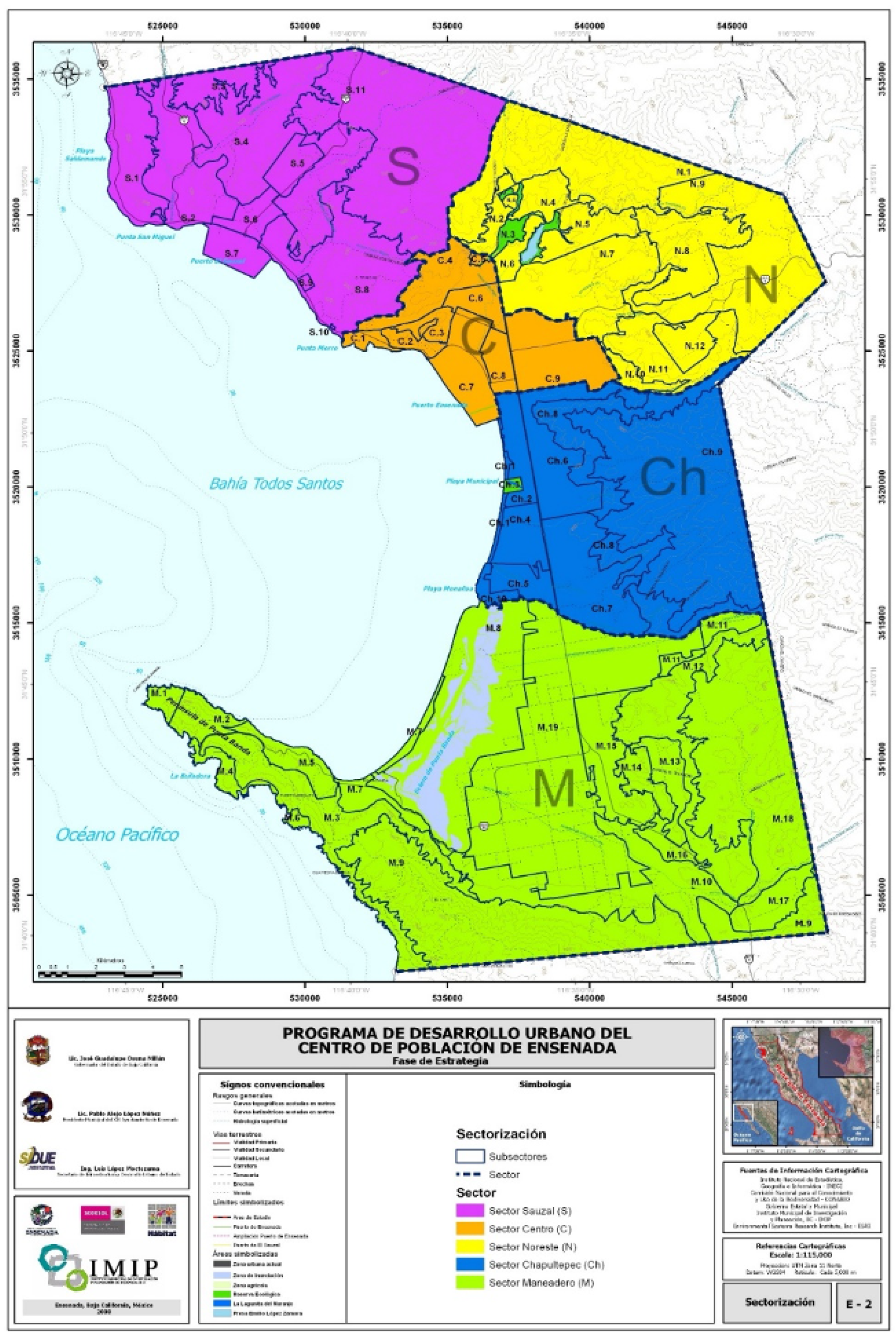
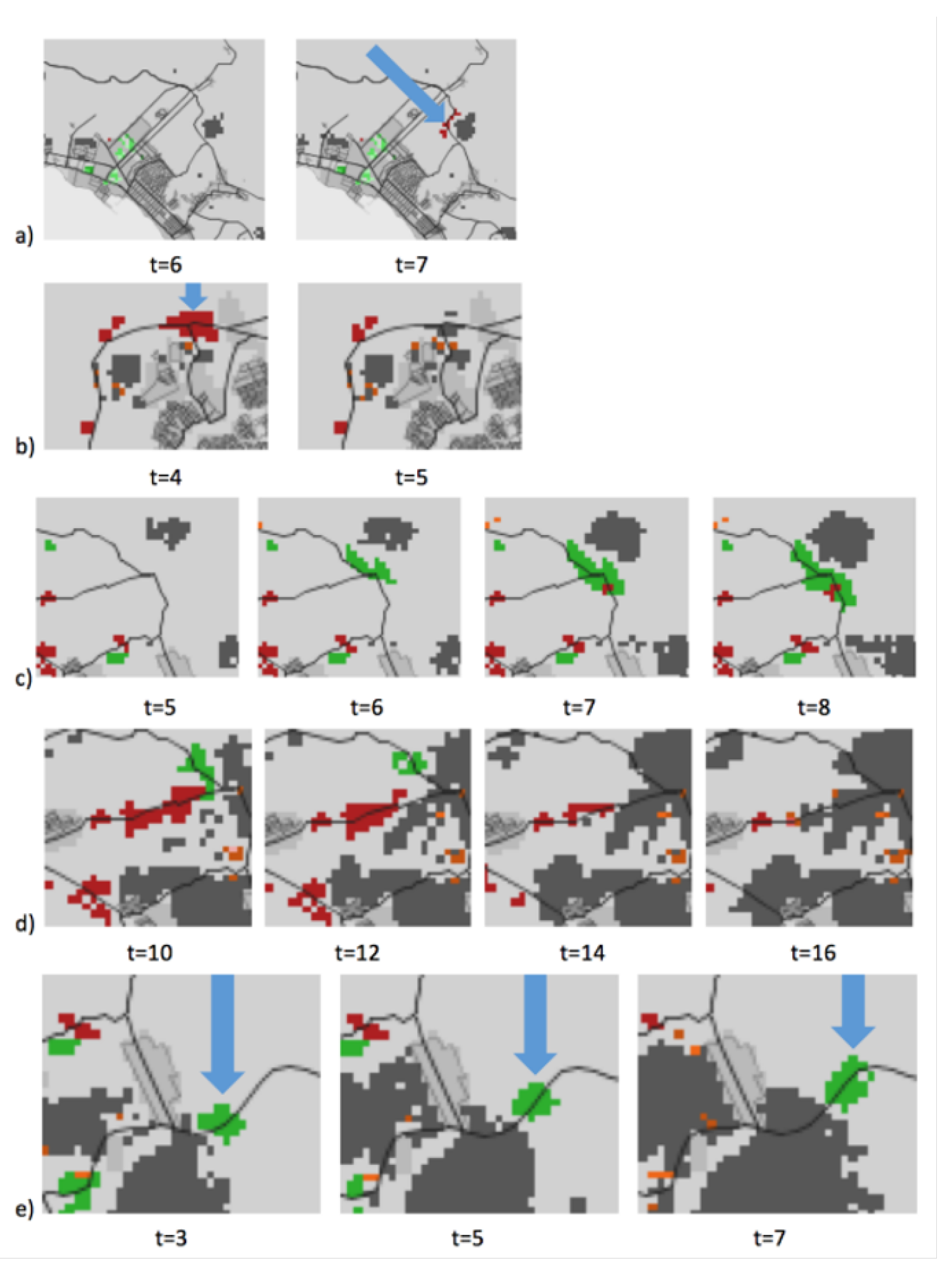

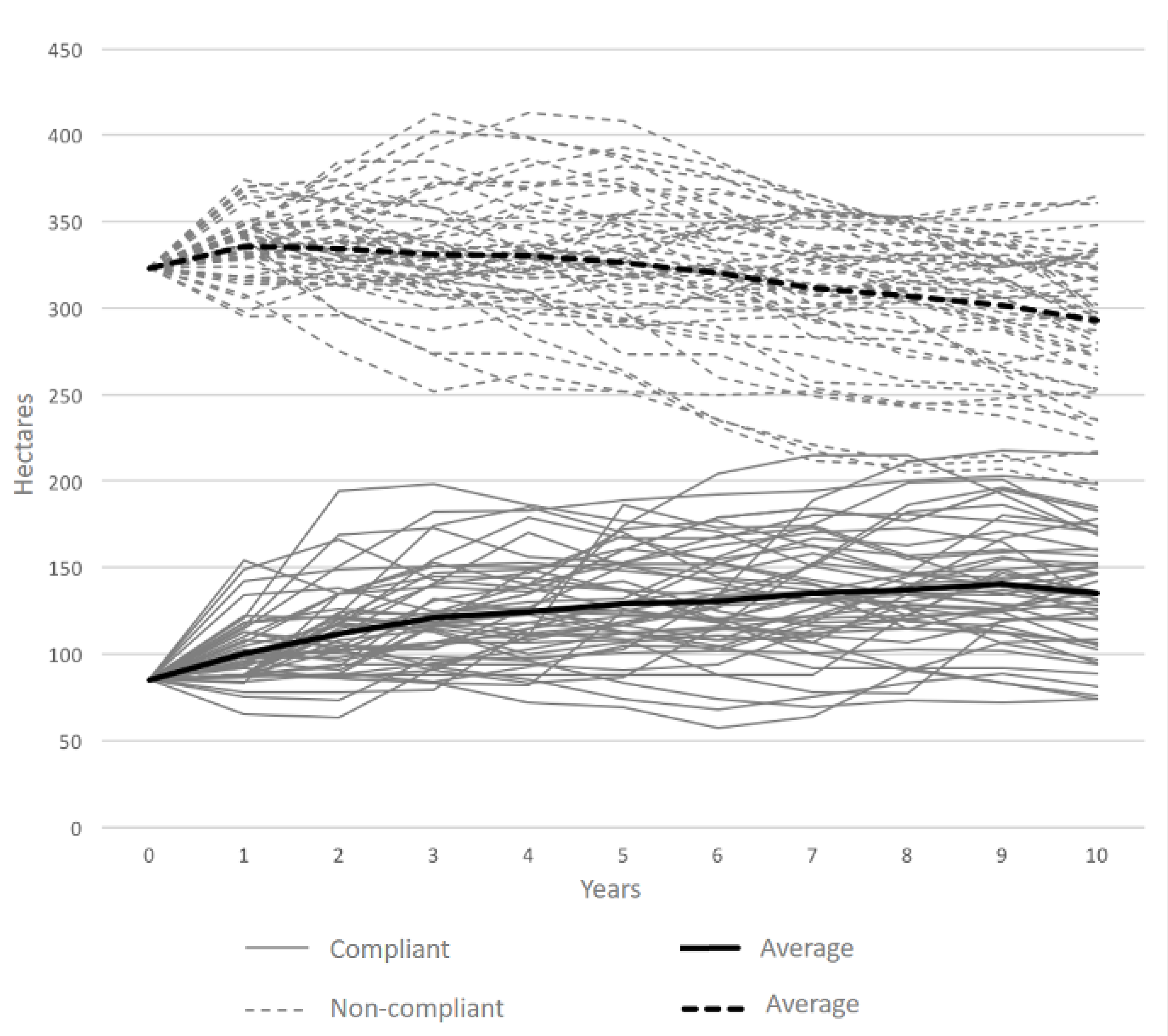
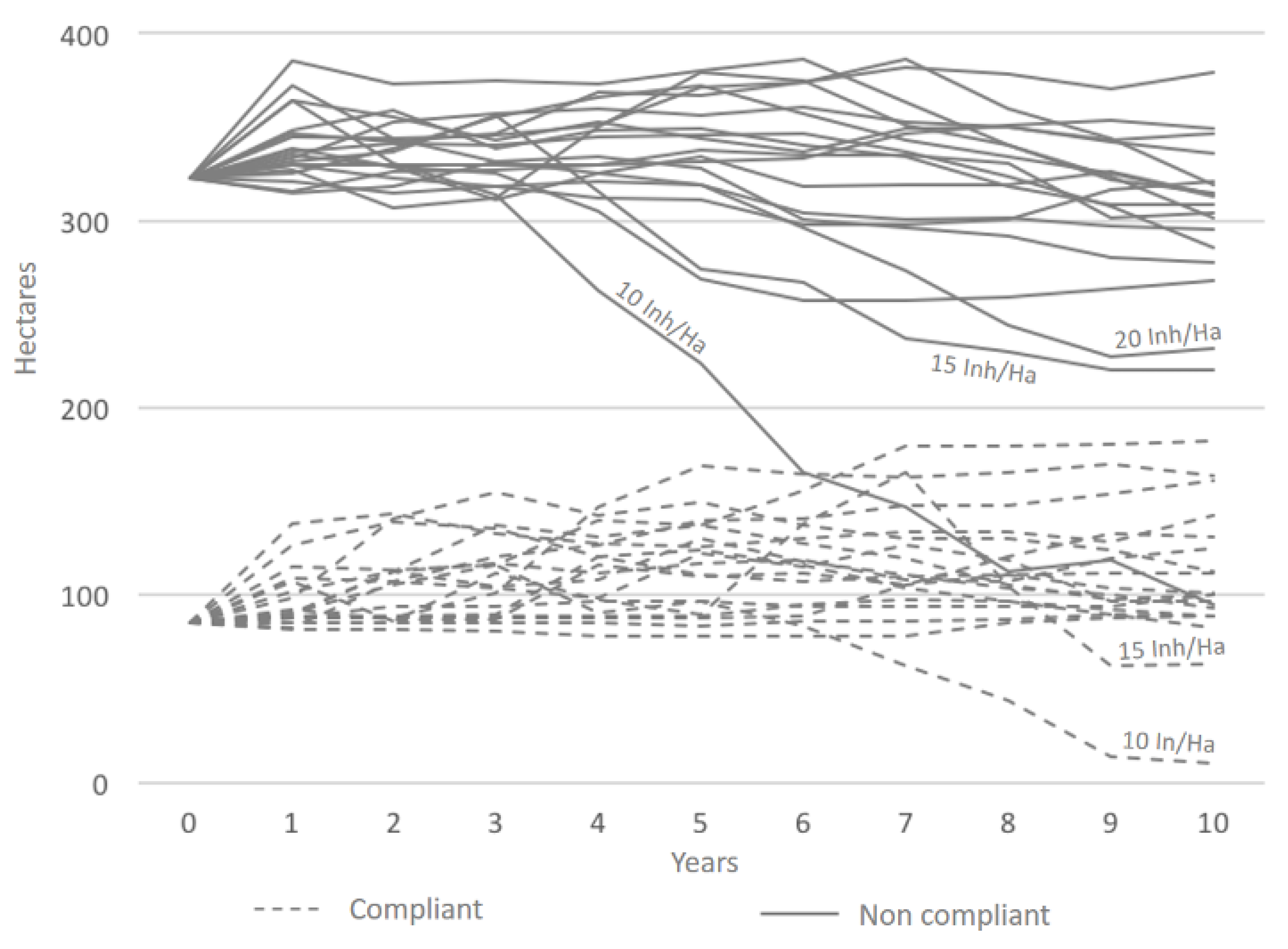
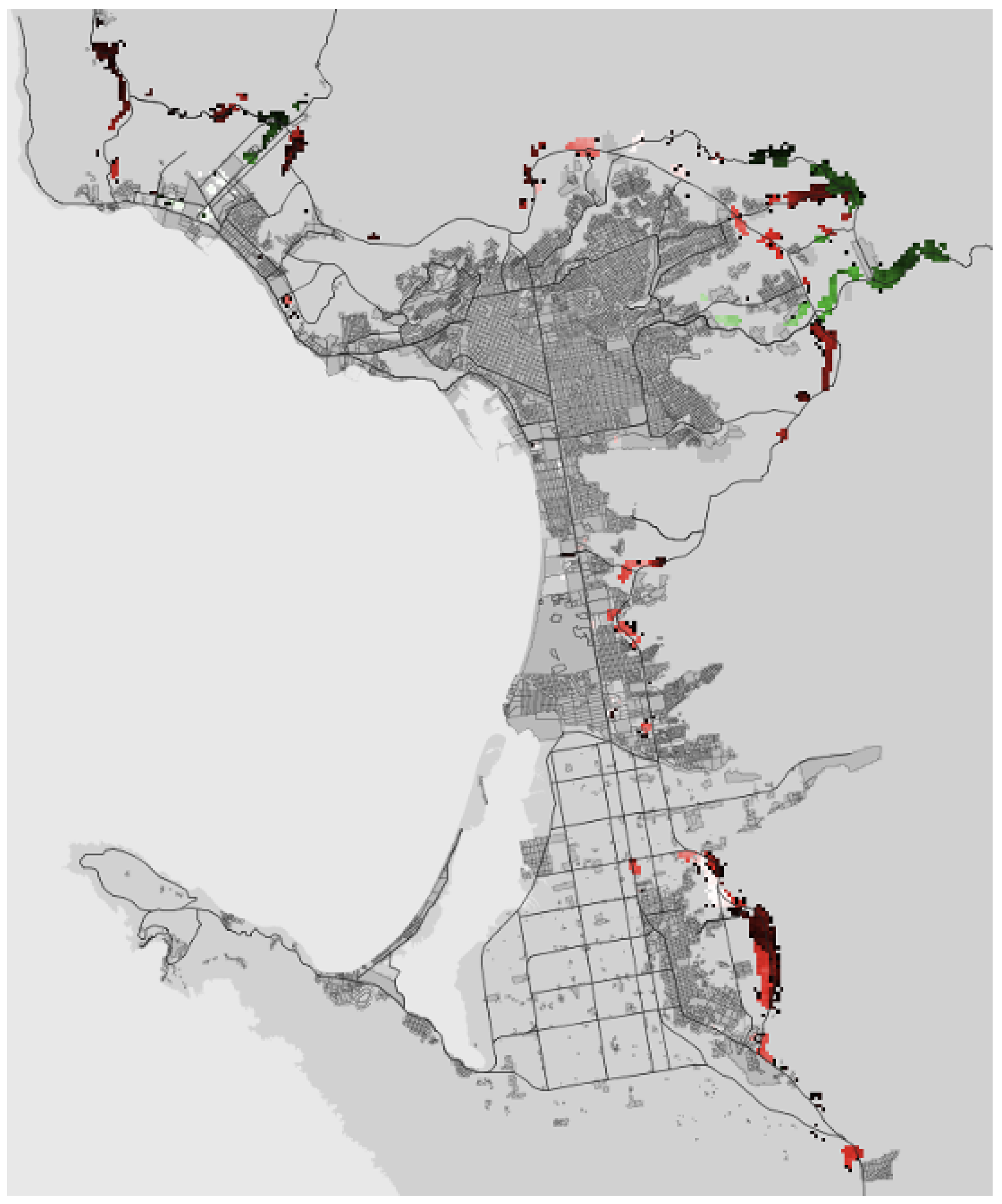
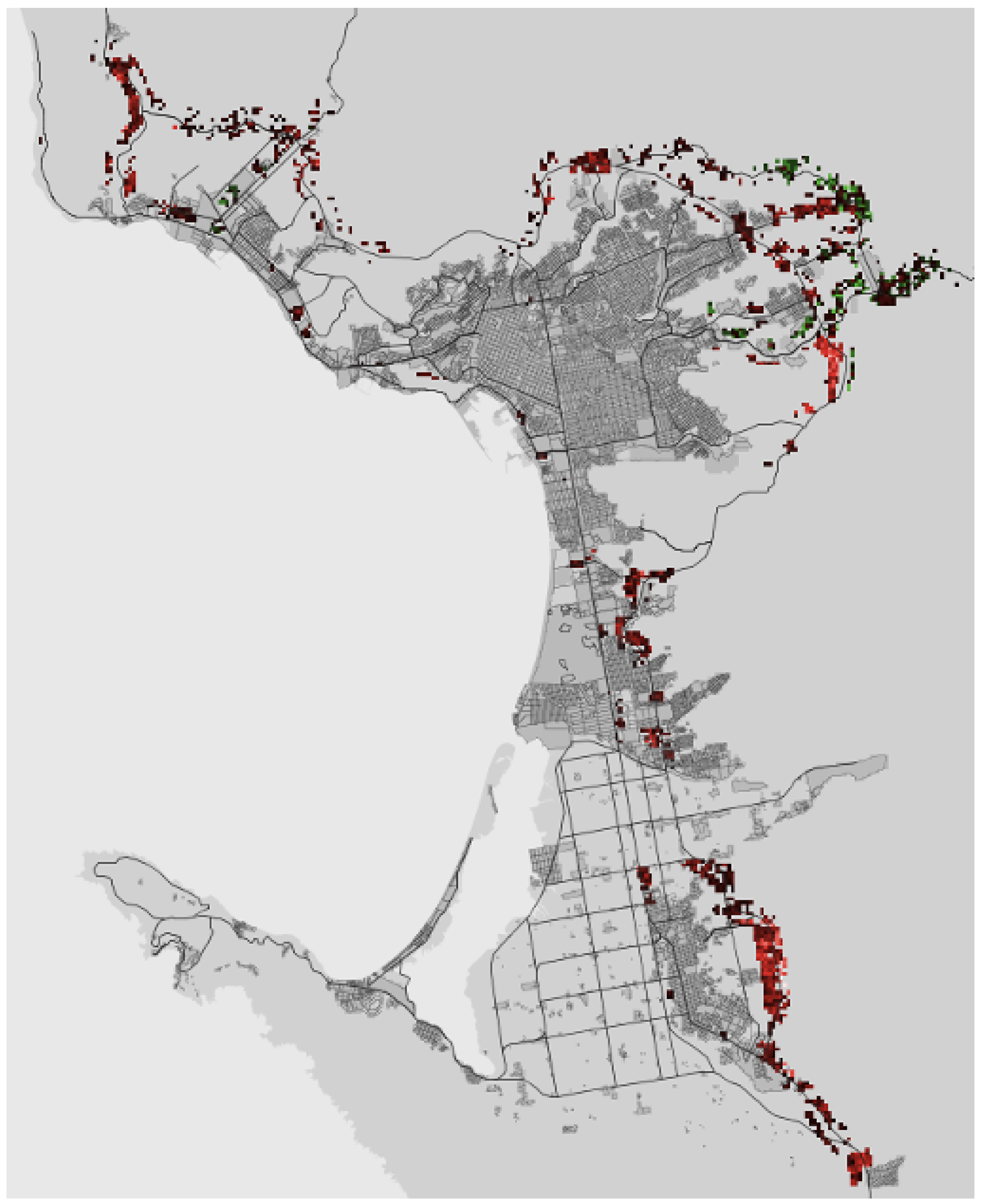
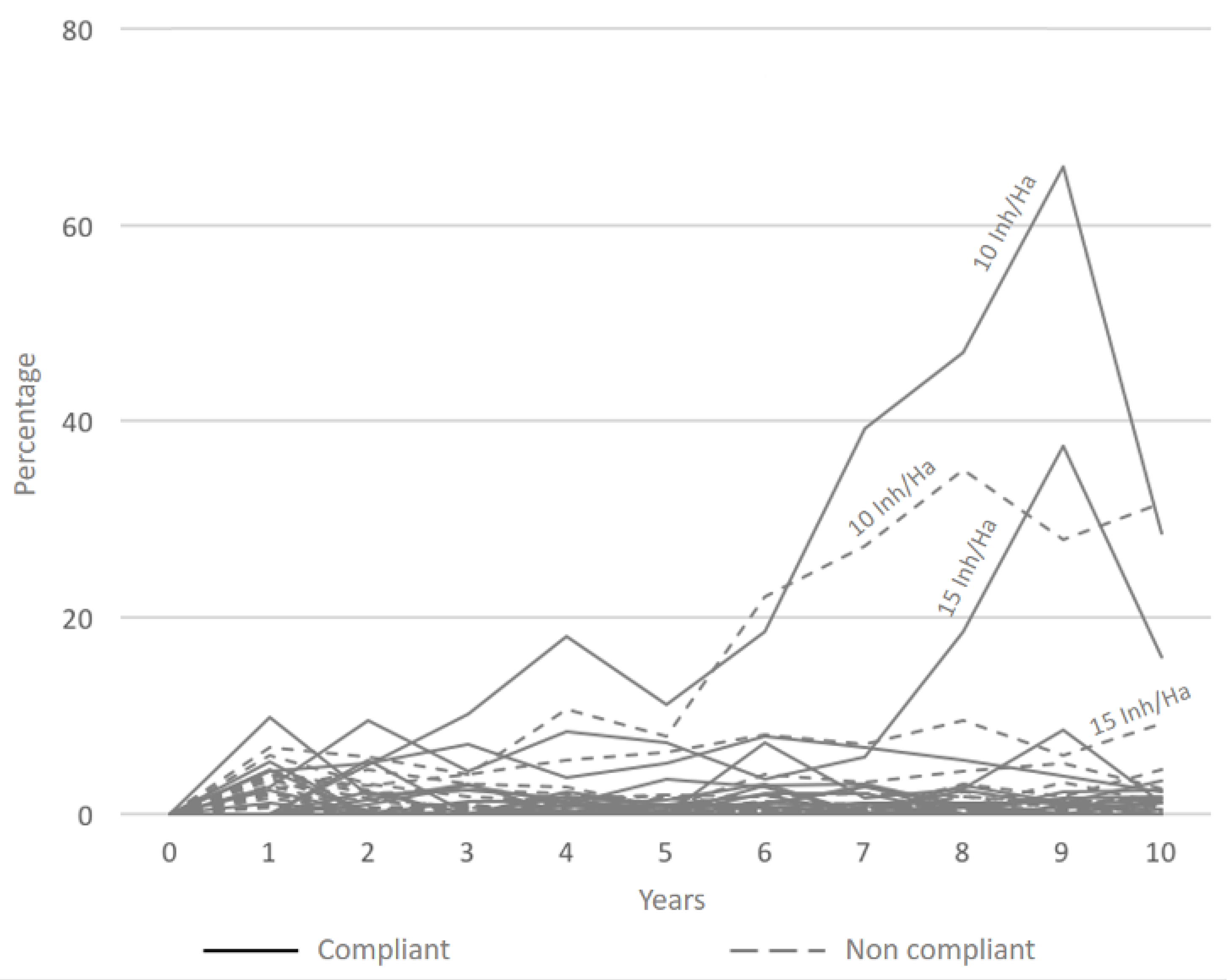
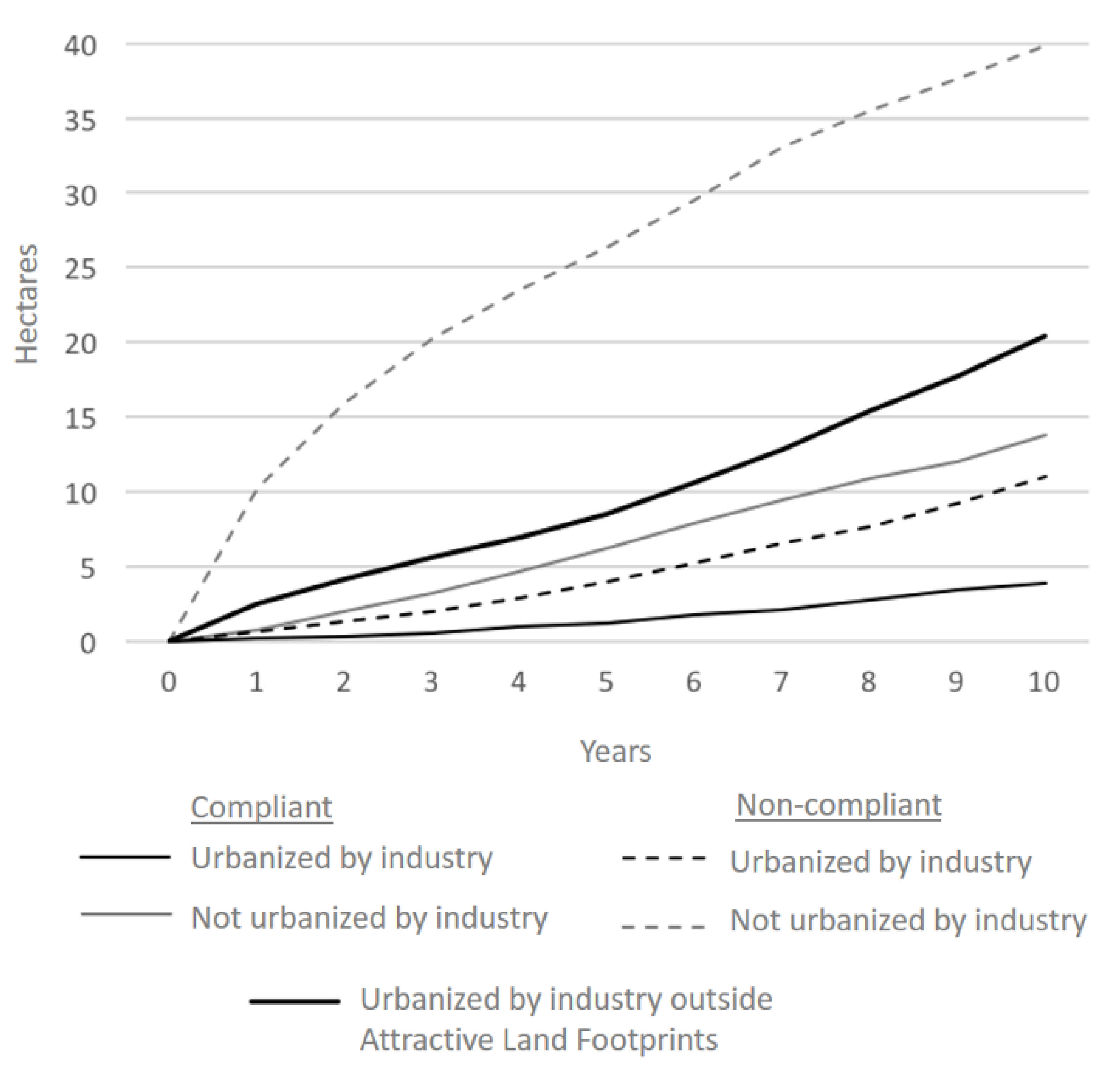
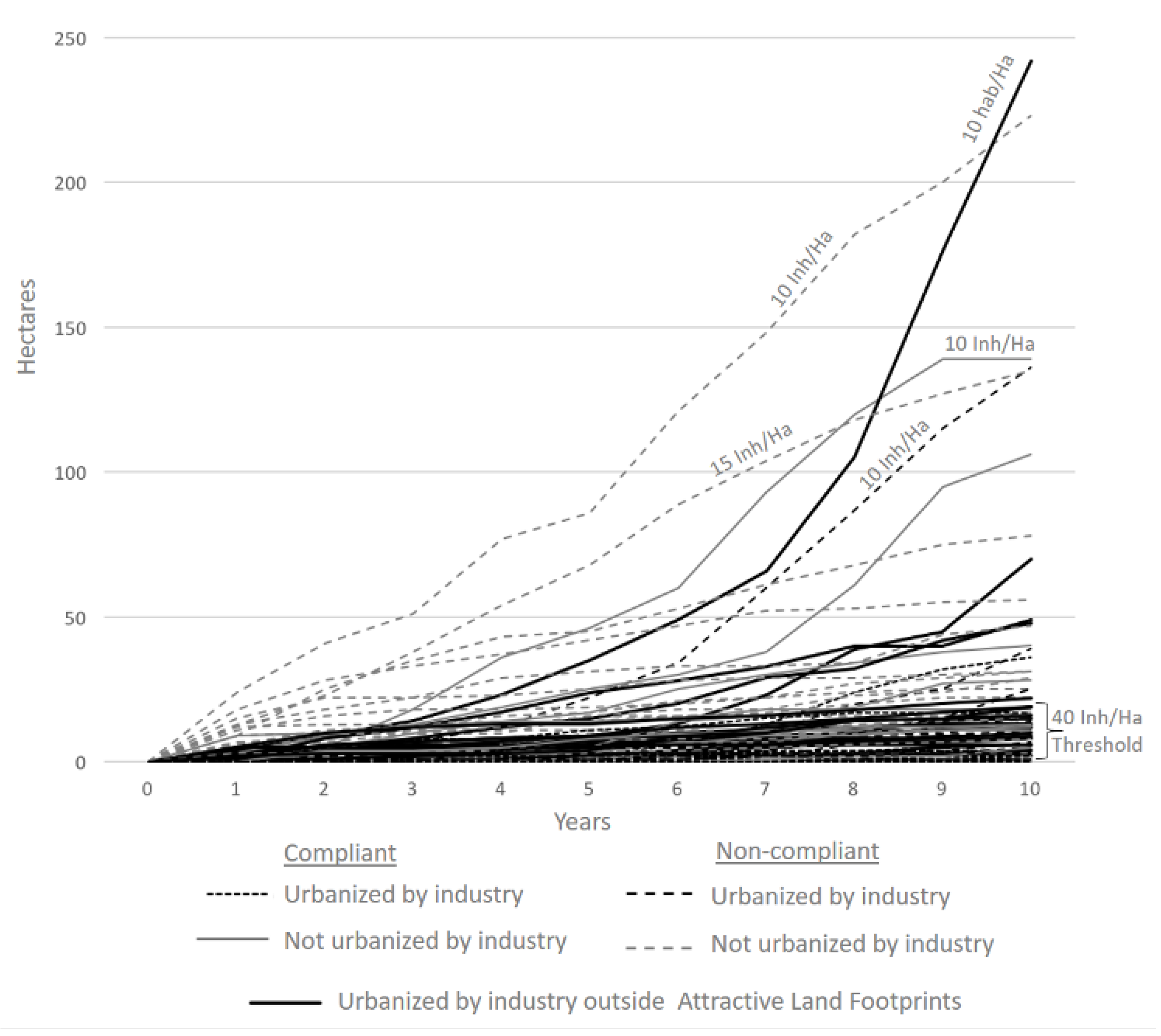
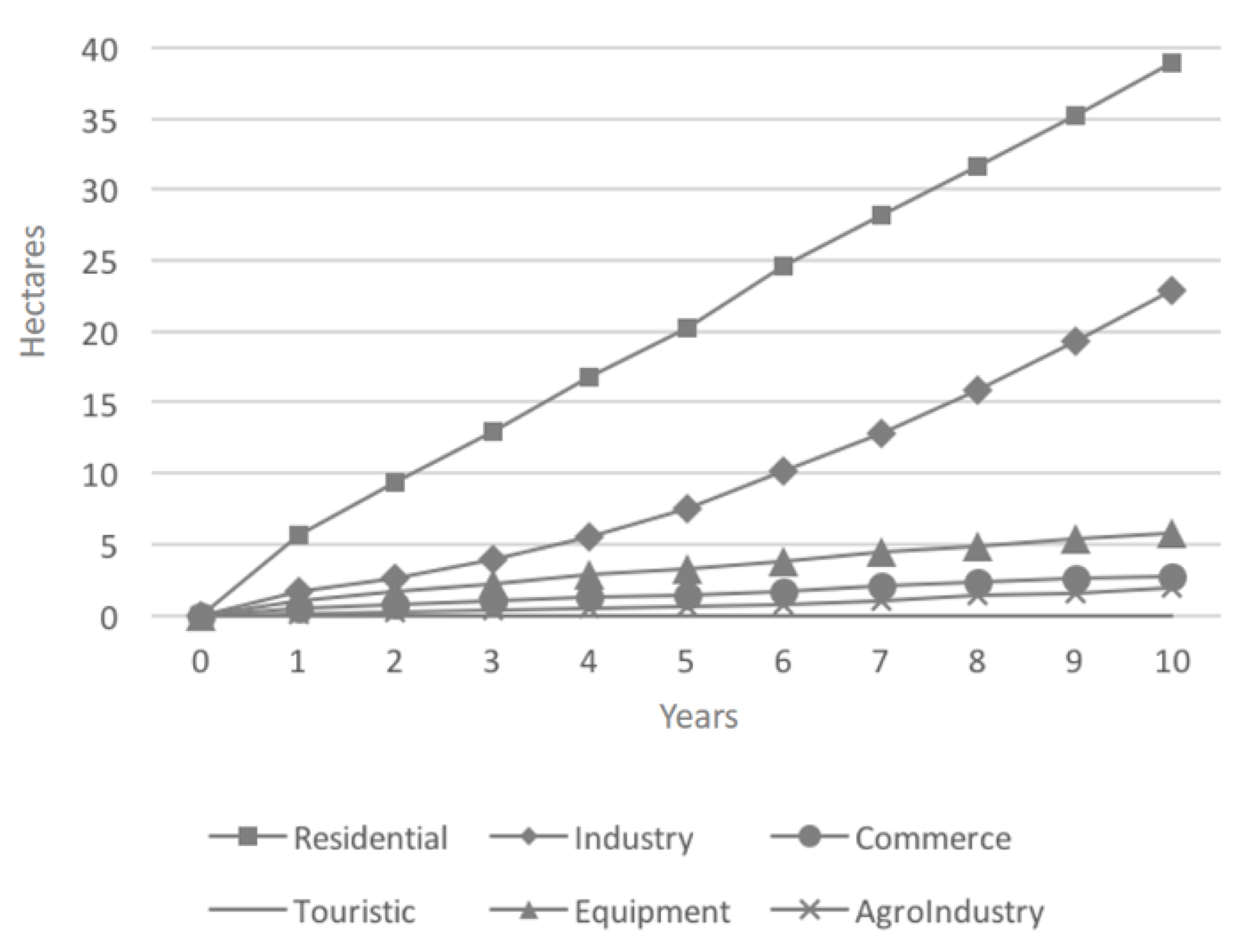
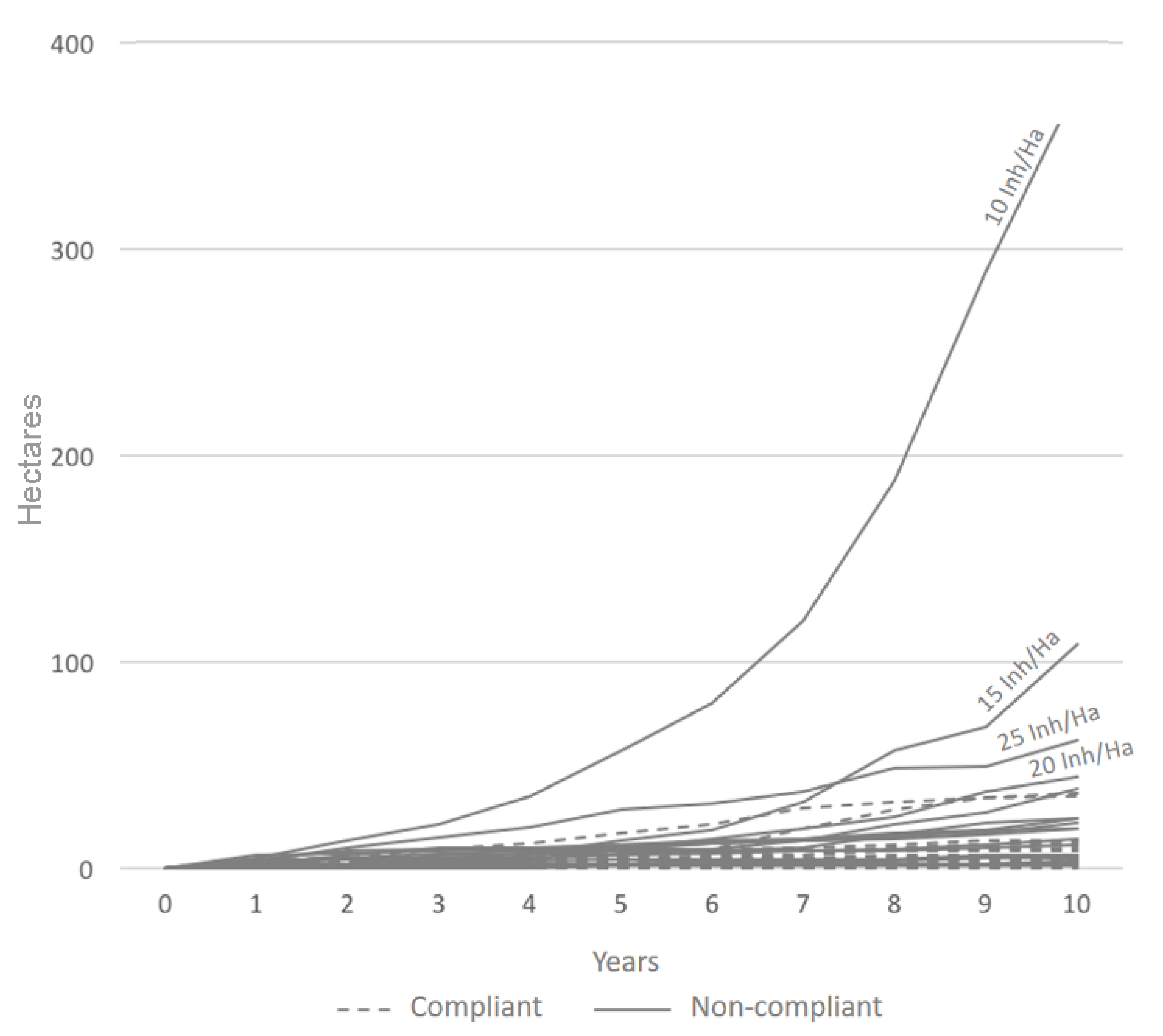
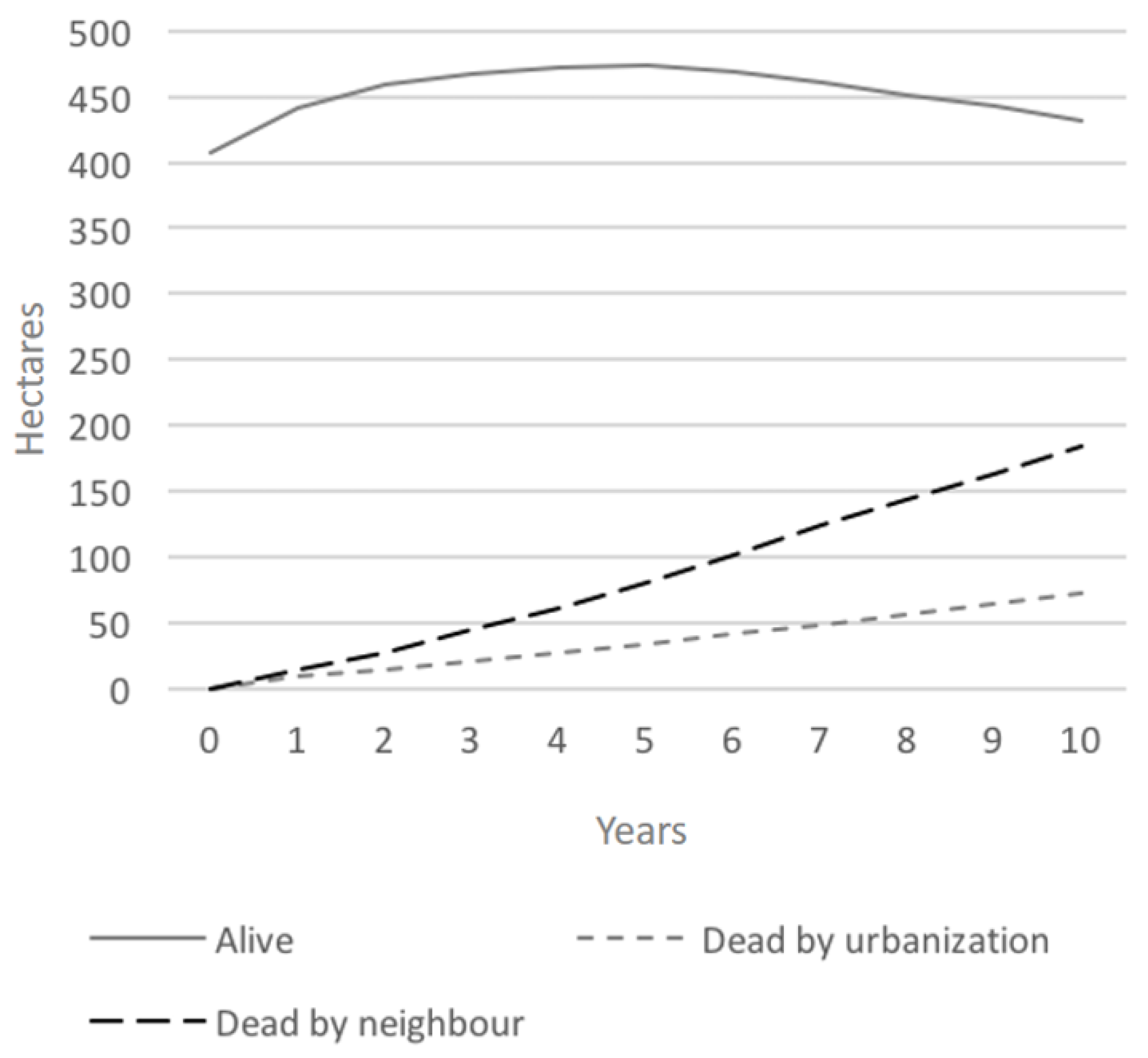
| Experiment | Output | Usefulness |
|---|---|---|
| Total Attractive Land Footprint. | Amount of Attractive Land Surface availability in conditions of compatibility and incompatibility with UDPE regulations. | Identify the availability of industry-attractive vacant land in compliance with UDPE regulations and to determine if industrial land reserves are on par with demand. |
| Percentage of urbanized Attractive Land Footprint. | Percentage of vacant land that was attractive to industry real estate but is now occupied by any land use. | Understand the occupation of industry-attractive vacant land under different population density scenarios. |
| Urbanized Attractive Land Footprint differentiated by compatibility. | Amount of vacant land surface that was attractive to industry real estate but is now occupied by any land use, differentiated by law compliance. | Helps to identify deficits in industrial zoning or lack of compliance with the UDPE, and in this way assess the need to add new zoning or update industrial regulations. |
| Urbanized attractive land footprint differentiated by land use. | Amount of vacant land that was attractive to industry real estate but is now occupied, differentiated by land-use occupation. | To estimate the competition of various land uses for the same industry-attractive vacant land. |
| Industry location differentiated by compatibility with the UDPE. | Amount of industrial surface that is compatible or incompatible with UDPE regulations. | To know the amount and location of industry surface in locations that are not allowed by UDPE regulation. |
| Attractive land footprint state. | Identify Attractive Land Footprints that are “alive” (vacant and desirable) or “dead” (once vacant but now urbanized, or vacant but no longer desirable because of its neighboring land uses). | Identify zones with a high competition for industry-attractive vacant land. |
| Experiment | Findings |
|---|---|
| Total Attractive Land Footprint. | - There will always be more industry-attractive vacant land in normative incompatibility than in normative compatibility with thw UDPE.
-The demand for industrial zoning is higher than the one established by the UDPE. - In low population densities secnarios between 10 to 20 inhabitants per hectare, Attractive Land drops steeply. - Emergence of an Attractive Land corridor along a regional road that communicates the northeast part of the city. - Low possibility of industry-attractive vacant land is occupied by this activity in almost all parts of the city, except two zones, but they regional roads are needed and are not compatible with UDPE regulations. |
| Percentage of urbanized Attractive Land Footprint. | - In low densities of 10 to 15 inhabitants per hectare, urbanization of Attractive Land Footprints tends to increase by up to 65%, compared to up to 14% when 35 inhabitants per hectare. |
| Urbanized Attractive Land Footprint differentiated by compatibility. | - Predominance of industry-attractive vacant land occupied by land-uses unrelated to this activity.
- The most desirable scenario, industry-attractive vacant land occupied by industry and in accordance to UDPE regulations, was in last place in simulation results. - In low population density scenario between 10 to 20 inhabitants/ha, urbanization of industry-attractive vacant land rises rapidly, and occupied by non-industrial land uses. - In densities of approximately 40 Inhabitants/ha or higher, industrial surface outside of industry-attractive vacant land is low, which is a desired condition. - There is a moderate possibility of industry-attractive vacant land urbanization in most of the city’s northeastern sector. Northern and southern areas have the same possibility but is not allowed by the UDPE. |
| Urbanized attractive land footprint differentiated by land use. | - Residential land use mostly occupies industry-attractive vacant land, replicating current real-world competition between these two land uses. |
| Industry location differentiated by compatibility with the UDPE. | - In low densities between 10 to 25 hab/ha, the industrial surface in incompatible sub-sectors rises steeply over time.
- There are zones with a high possibility of emerging industry-attractive vacant land but are incompatible with UDPE regulations, and a projected road network must be built first. |
| Attractive land footprint state. | - In low density scenarios, alive surface immediately goes down at the same rate that the dead surface rises.
- In high density scenarios, dead surface rises at a faster rate than the surface that is alive. - Northeast corridor footprint: there is a high possibility of its urbanization by land uses other than industry. |
Publisher’s Note: MDPI stays neutral with regard to jurisdictional claims in published maps and institutional affiliations. |
© 2021 by the authors. Licensee MDPI, Basel, Switzerland. This article is an open access article distributed under the terms and conditions of the Creative Commons Attribution (CC BY) license (http://creativecommons.org/licenses/by/4.0/).
Share and Cite
Sandoval-Félix, J.; Castañón-Puga, M.; Gaxiola-Pacheco, C.G. Analyzing Urban Public Policies of the City of Ensenada in Mexico Using an Attractive Land Footprint Agent-Based Model. Sustainability 2021, 13, 714. https://doi.org/10.3390/su13020714
Sandoval-Félix J, Castañón-Puga M, Gaxiola-Pacheco CG. Analyzing Urban Public Policies of the City of Ensenada in Mexico Using an Attractive Land Footprint Agent-Based Model. Sustainability. 2021; 13(2):714. https://doi.org/10.3390/su13020714
Chicago/Turabian StyleSandoval-Félix, Javier, Manuel Castañón-Puga, and Carelia Guadalupe Gaxiola-Pacheco. 2021. "Analyzing Urban Public Policies of the City of Ensenada in Mexico Using an Attractive Land Footprint Agent-Based Model" Sustainability 13, no. 2: 714. https://doi.org/10.3390/su13020714
APA StyleSandoval-Félix, J., Castañón-Puga, M., & Gaxiola-Pacheco, C. G. (2021). Analyzing Urban Public Policies of the City of Ensenada in Mexico Using an Attractive Land Footprint Agent-Based Model. Sustainability, 13(2), 714. https://doi.org/10.3390/su13020714






